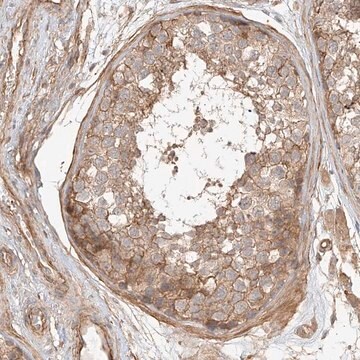SCC280
SCC-61 Human Squamous Cell Carcinoma Cell Line
SCC-61 human squamous cell carcinoma cell line is a good model for studying radiation resistance in SCC cancer cells.
Iniciar sesiónpara Ver la Fijación de precios por contrato y de la organización
About This Item
Código UNSPSC:
41106514
NACRES:
NA.81
Productos recomendados
aplicaciones
cell analysis
Descripción general
Squamous cell carcinoma of the head and neck (HNSCC) is the 9th-most common cancer worldwide and is characterized by a high rate of recurrence after therapy, with a median 5-year survival range of 40-50% (1). HNSCC tumors show a wide range of heterogeneity in response to radiation therapy. Cellular HNSCC models that demonstrate a range of radiation sensitivity are thus invaluable for elucidating the factors underlying radiation responses of cancer cells.
The SCC-61 HNSCC cell line, derived from an aggressive tongue squamous cell carcinoma (2), is an established model for HNSCC. SCC-61 cells are relatively sensitive to radiation compared to other HNSCC cell lines as well as a relatively stable genome (3). SCC-61 cells grow robustly and are strongly adherent in culture. SCC-61 cells have been characterized by positive expression of the SCC marker p63 (p40) (4). SCC-61 cells have demonstrated utility in studies parsing mechanisms of radio-resistance in SCC tumor cells, as demonstrated by transformation of this cell line with factors conferring radio-resistance (5).
<bold>Source:</bold>
SCC-61 cell line was derived from a tongue squamous cell carcinoma of a male patient (2).
Research Category:
Cancer
The SCC-61 HNSCC cell line, derived from an aggressive tongue squamous cell carcinoma (2), is an established model for HNSCC. SCC-61 cells are relatively sensitive to radiation compared to other HNSCC cell lines as well as a relatively stable genome (3). SCC-61 cells grow robustly and are strongly adherent in culture. SCC-61 cells have been characterized by positive expression of the SCC marker p63 (p40) (4). SCC-61 cells have demonstrated utility in studies parsing mechanisms of radio-resistance in SCC tumor cells, as demonstrated by transformation of this cell line with factors conferring radio-resistance (5).
<bold>Source:</bold>
SCC-61 cell line was derived from a tongue squamous cell carcinoma of a male patient (2).
Research Category:
Cancer
Origen línea celular
Human, Cancer Cells
Envase
≥1X106 cells/vial
Almacenamiento y estabilidad
Store in liquid nitrogen. The cells can be cultured for at least 10 passages after initial thawing without significantly affecting the cell marker expression and functionality.
Otras notas
This product is intended for sale and sold solely to academic institutions for internal academic research use per the terms of the “Academic Use Agreement” as detailed in the product documentation. For information regarding any other use, please contact licensing@emdmillipore.com.
Cláusula de descargo de responsabilidad
Unless otherwise stated in our catalog or other company documentation accompanying the product(s), our products are intended for research use only and are not to be used for any other purpose, which includes but is not limited to, unauthorized commercial uses, in vitro diagnostic uses, ex vivo or in vivo therapeutic uses or any type of consumption or application to humans or animals.
Código de clase de almacenamiento
10 - Combustible liquids
Clase de riesgo para el agua (WGK)
WGK 1
Punto de inflamabilidad (°F)
Not applicable
Punto de inflamabilidad (°C)
Not applicable
Certificados de análisis (COA)
Busque Certificados de análisis (COA) introduciendo el número de lote del producto. Los números de lote se encuentran en la etiqueta del producto después de las palabras «Lot» o «Batch»
¿Ya tiene este producto?
Encuentre la documentación para los productos que ha comprado recientemente en la Biblioteca de documentos.
Nuestro equipo de científicos tiene experiencia en todas las áreas de investigación: Ciencias de la vida, Ciencia de los materiales, Síntesis química, Cromatografía, Analítica y muchas otras.
Póngase en contacto con el Servicio técnico





